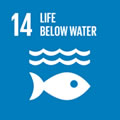Por favor, use este identificador para citar o enlazar a este item:
http://hdl.handle.net/10261/332486COMPARTIR / EXPORTAR:
 SHARE SHARE
 CORE
BASE CORE
BASE
|
|
| Visualizar otros formatos: MARC | Dublin Core | RDF | ORE | MODS | METS | DIDL | DATACITE | |

| Título: | Long distance dispersal and oceanographic fronts shape the connectivity of the keystone sponge Phakellia ventilabrum in the deep northeast Atlantic |
Autor: | Taboada, Sergi; Whiting, Connie; Wang, Shuangqiang; Ríos, Pilar; Davies, Andrew J.; Mienis, Furu; Kenchington, Ellen; Cárdenas, Paco; Cranston, Alex; Koutsouveli, Vasiliki; Cristobo, Javier; Rapp, Hans Tore; Drewery, Jim; Baldó, Francisco CSIC ORCID ; Morrow, Christine; Piton, Bernard; Xavier, Joana R. CSIC ORCID; Arias, María Belén; Leiva, Carlos; Riesgo Gil, Ana | Palabras clave: | ddRADSeq Panmixis Oceanographic modelling Genetic differentiation Reproductive cycle SNPs |
Fecha de publicación: | 16-jun-2023 | Editor: | Frontiers Media | Citación: | Deep-Sea Environments and Ecology (2023) | Resumen: | Little is known about dispersal in deep-sea ecosystems, especially for sponges, which are abundant ecosystem engineers. Understanding patterns of gene flow in deep-sea sponges is essential, especially in areas where rising pressure from anthropogenic activities makes difficult to combine management and conservation. Here, we combined population genomics and oceanographic modelling to understand how Northeast Atlantic populations (Cantabrian Sea to Norway) of the deep-sea sponge Phakellia ventilabrum are connected. The analysis comprised ddRADseq derived SNP datasets of 166 individuals collected from 57 sampling stations from 17 different areas, including two Marine Protected Areas, one Special Area of Conservation and other areas with different levels of protection. The 4,017 neutral SNPs used indicated high connectivity and panmixis amongst the majority of areas (Ireland to Norway), spanning ca. 2,500-km at depths of 99–900 m. This was likely due to the presence of strong ocean currents allowing long-distance larval transport, as supported by our migration analysis and by 3D particle tracking modelling. On the contrary, the Cantabrian Sea and Roscoff (France) samples, the southernmost areas in our study, appeared disconnected from the remaining areas, probably due to prevailing current circulation patterns and topographic features, which might be acting as barriers for gene flow. Despite this major genetic break, our results suggest that all protected areas studied are well-connected with each other. Interestingly, analysis of SNPs under selection replicated results obtained for neutral SNPs. The relatively low genetic diversity observed along the study area, though, highlights the potential fragility of this species to changing climates, which might compromise resilience to future threats. | Versión del editor: | https://doi.org/10.3389/fmars.2023.1177106 | URI: | http://hdl.handle.net/10261/332486 | DOI: | 10.3389/fmars.2023.1177106 | E-ISSN: | 2296-7745 |
| Aparece en las colecciones: | (MNCN) Artículos (IEO) Artículos |
Ficheros en este ítem:
| Fichero | Descripción | Tamaño | Formato | |
|---|---|---|---|---|
| Riesgo_A_Long.pdf | Artículo principal | 8,59 MB | Adobe PDF |  Visualizar/Abrir |
CORE Recommender
SCOPUSTM
Citations
2
checked on 21-abr-2024
WEB OF SCIENCETM
Citations
1
checked on 23-feb-2024
Page view(s)
38
checked on 23-abr-2024
Download(s)
32
checked on 23-abr-2024
Google ScholarTM
Check
Altmetric
Altmetric
Este item está licenciado bajo una Licencia Creative Commons



